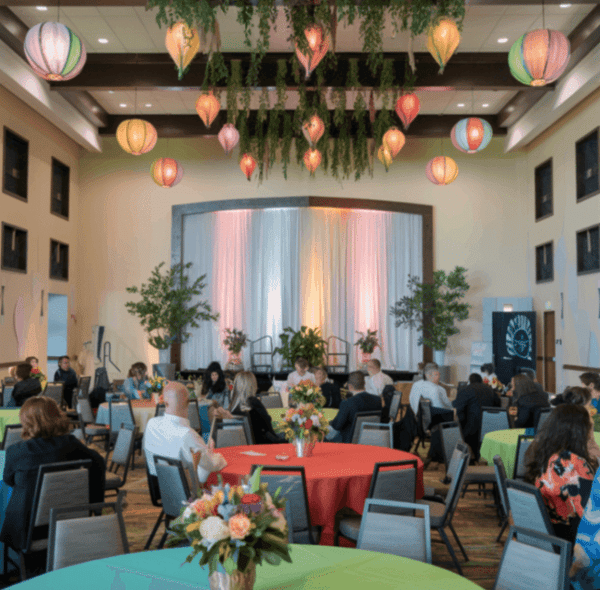Event planning today is more than just organizing details—it’s about creating an experience that truly connects with your attendees and aligns with your goals. Over time, it has become more data-driven, creative, and highly focused on delivering what attendees want.
Pulling off a successful event requires adaptability, with each stage benefiting from practical, actionable tips that make the process smoother and less stressful.
In this article, you’ll discover essential event planning tips that save you time, help you avoid surprises, and provide a clear roadmap for a seamless, successful event. From setup to wrap-up, these strategies guide you through every step, keeping things on track and reducing last-minute headaches.
Discover everything you need to know about live event planning in our article, 'Live Event Planning: The Ultimate Guide to Hosting Successful Events.'
Why Are Event Planning Tips Important?
When it comes to planning your events, having structured tips makes a big difference in keeping things consistent, especially if you’re hosting multiple or recurring events. These tips help you create a recognizable style and experience that gives returning attendees a sense of familiarity and quality they can rely on.
Event planning tips also make teamwork easier. With clear guidance on priorities, each team member knows exactly where to focus, reducing miscommunication and making coordination smoother.
This structure is especially valuable when different teams handle various parts of the event, helping everyone stay aligned and work toward the same goal.
Plus, specific tips let you plan proactively. By anticipating potential challenges, you and your team are better prepared to handle any surprises, creating a seamless experience for everyone involved.
“An effective set of event planning tips acts as a guide to cover every detail, ensuring that each phase of the event runs smoothly and meets expectations.” — Petri Hollmén, CEO of Lyyti.
Foundational Event Planning Tips
Deep Dive into Past Events
To plan better events, it’s essential to understand what worked and what didn’t in the past. A post-event retrospective helps you pinpoint successes and areas for improvement. By reviewing attendee feedback, team performance, and results, you can carry forward what worked and make targeted changes to avoid repeating mistakes.
Celebrate Successes: Acknowledge what went well to boost team morale.
Identify Challenges: Highlight areas that need a different approach.
Use Feedback: Incorporate attendee insights to improve future events.
Retrospectives also help your team work better together. By discussing the event openly, everyone gets on the same page, feels heard, and contributes to improving the next event. It’s a simple step that makes a big difference.
For more detailed guidance on refining your event planning process, check out How to Run a Post-event Retrospective, with a Downloadable Template to enhance your future events.
Define Clear Event Objectives
Breaking down your event objectives can make a huge difference in focusing your team’s efforts effectively. Start by categorizing objectives into primary goals—like boosting brand awareness or increasing leads—and secondary goals that are beneficial but not essential.
Primary goals
Secondary goals
Prioritize for clarity
To make objectives even more actionable, consider using the SMART framework, as it brings clarity and focus to your goals. By setting objectives that are Specific, Measurable, Achievable, Relevant, and Time-bound, you ensure that every aspect of planning has a clear direction.
This structured approach makes it easier to track progress and adjust plans as needed, ultimately helping the event meet its intended goals more effectively.
Understand Your Audience
Knowing your audience is key to designing an event that resonates. Go beyond demographics and create detailed personas that consider behaviors, expectations, and motivations.
Demographics and behaviors
Audience expectations
Attendee motivations
Understanding your audience’s preferences and expectations can make all the difference in crafting a successful event. Gathering insights directly from attendees lets you fine-tune your approach and make informed decisions.
Pre-event surveys or social media polls provide real-time feedback, helping you tailor content and experiences to their specific interests. The more you know, the better you can create an event that truly resonates and leaves a lasting impression.
Align Event Goals with Business ROI
Ensuring your event supports broader business objectives makes it a strategic investment. For each event goal, set measurable metrics, such as the number of new leads for sales or social shares for brand visibility.
Set measurable metrics
Link to business objectives
Track both short-term and long-term goals
Considering both Return on Investment (ROI) and Return on Experience (ROE) is essential to capturing the event’s full impact. ROI helps measure direct financial returns, while ROE reflects attendee satisfaction, engagement, and brand perception.
Tracking these two elements offers a well-rounded perspective: ROI shows immediate business gains, while ROE reveals insights into attendee loyalty and the overall event experience.
Together, these metrics allow you to refine your approach, strengthen your brand image, and continually adapt to meet future event financial and experiential goals.
Optimize your event strategy by focusing on the data that matters most. See how Lyyti’s real-time insights can drive measurable ROI with reporting and event data.
Attendee Engagement and Communication Tips
Develop a Comprehensive Communication Plan
A well-thought-out communication plan ensures attendees feel connected and engaged throughout the event. Start by establishing a communication timeline to keep participants informed and excited, spanning the pre-event build-up, on-the-day updates, and post-event follow-ups.
Pre-event communication
On-the-day updates
Post-event follow-ups
Personalizing your communication is also key to making attendees feel truly valued. By leveraging attendee data, you can send tailored messages that address each segment’s specific interests or needs, rather than sending generic updates.
This thoughtful, customized approach keeps attendees engaged, fosters a sense of connection, and ultimately builds a stronger, more lasting relationship with your audience.
For a detailed guide on crafting an effective communication plan and engaging your audience seamlessly, Download a complete event marketing plan example to take your event strategy to the next level.
Design Engaging Content
Creating content that resonates with attendees makes your event memorable and interactive. Encourage formats that allow for real-time participation, like live demonstrations or behind-the-scenes insights, which bring attendees closer to the action.
Live demonstrations
Behind-the-scenes insights
Interactive content formats
To amplify social buzz and create lasting impressions, carefully design micro-moments and interactive experiences throughout the event that encourage attendees to engage and share.
These could include photo-worthy stations or unique experiences that attendees are excited to share on social media, extending the event's reach beyond those who are physically there.
Think of small touches like interactive backdrops, branded props, or even a dedicated “selfie spot” that encourages people to take photos and tag your event.
By adding these shareable moments, you not only create memorable experiences for your guests but also boost visibility online. Each post, tag, or story shared by attendees spreads the word and builds excitement, making others feel like they’re part of the event even if they’re not there.
Plan for Audience Engagement Early
Planning for engagement from the outset ensures that attendees stay involved throughout. Gamification strategies, such as reward systems or points for participation, motivate attendees and keep them actively involved in sessions and activities.
Gamification strategies
Rewards for participation
Points for Engagement
It's also a smart move to have backup engagement plans in place, ready to jump in and boost energy when needed. Have options like extra polls, quick interactive challenges, or even surprise giveaways prepared to keep the momentum alive and maintain attendee interest during slower segments.
These spontaneous elements can re-energize the crowd and make the experience feel dynamic and exciting. By being flexible and prepared with these engagement strategies, you'll create an immersive event that keeps your audience involved and invested from start to finish, leaving them with a memorable and impactful experience.
Reach your right target audience with the right communication! By tailoring your message to resonate with your audience, you can create a personal and impactful experience.
Data-Driven Event Optimization Tips
Utilize Data-Driven Insights for Enhanced Event Strategy
Using data insights can help you refine your event strategy, tailoring it to what truly resonates with attendees. Start by segmenting data based on session type or attendee behavior—this allows you to identify which elements are the most engaging and effective, guiding improvements for future events.
Segment data by session type
Analyze attendee behavior
Identify high-engagement areas
Using predictive analytics can also enhance personalization, as it allows you to anticipate attendee preferences and customize the experience accordingly.
For example, if data shows certain topics are popular among your audience, you can prioritize these in future events. This proactive approach helps create a more relevant and impactful experience, setting the stage for greater attendee satisfaction.
Implement Efficient Registration Processes
Streamlining the registration process improves both the attendee experience and data collection. One effective approach is to use a dynamic registration form that adapts based on attendee selections. This ensures smooth sign-ups while gathering targeted information that enriches the attendee profile.
Use dynamic registration forms
Gather targeted attendee data
Simplify sign-up flow
Automating post-registration steps like confirmation emails, welcome messages, and reminders can significantly enhance the attendee experience while easing your team's administrative burden.
These automated touches create a seamless, professional impression right from the start, helping attendees feel valued and well-informed. Each step—from a personalized confirmation to a friendly reminder—keeps them engaged and excited about the event, reducing the chance of no-shows.
By maintaining regular communication, attendees know exactly what to expect, fostering a smooth and welcoming experience that builds trust and satisfaction and setting a positive tone for the entire event.
Monitor and Evaluate Event Performance
Tracking event performance in real-time allows you to make immediate adjustments that enhance attendee satisfaction. A real-time event dashboard can be invaluable, offering live insights into metrics like attendance, engagement, and feedback. This tool enables you to react swiftly, for instance, by adding more Q&A time if you notice high interaction rates.
Real-time event dashboard
Track live engagement metrics
Adjust on the spot for better satisfaction
After the event, it's a great idea to create performance summaries for each team involved. This helps you see what went well and what areas could use improvement.
By sharing these insights, each team gains a better understanding of what worked and where adjustments can be made, making it easier to plan and coordinate for future events.
These summaries allow everyone to learn from the experience, building on successes and addressing any challenges so your next event runs even smoother.
But here’s where it comes full circle; “a post-event retrospective”. Revisiting the retro ensures that all performance insights are fed back into your planning process, creating a continuous improvement loop. By incorporating tools like the Experience Value Score (EVS), you can capture attendee feedback effortlessly and identify actionable steps to enhance future events.
Conclusion
Following these targeted event planning tips can bring much-needed clarity and efficiency to your process, making it easier to manage each stage and avoid common pitfalls. By incorporating these strategies, you’re setting yourself up for an event that’s not only well-organized but also memorable for attendees.
To make the process even smoother, Lyyti’s platform provides comprehensive solutions that cover everything from essential event planning tips to post-event evaluation. With tools designed to support every step, you can streamline your workflow and focus on creating an impactful event experience.
Ready to see how Lyyti can elevate your planning? Book a demo today and explore how our tailored tools can support and enhance your event planning journey.
FAQ
What are the first steps in planning a successful event?
Begin by defining clear objectives that outline what you want to achieve. Understanding your audience is equally crucial, as it allows you to create an event that resonates with their needs and interests. With these foundations in place, you can build a focused strategy that aligns with your goals and ensures a meaningful experience for attendees.
How can I keep attendees engaged during the event?
To keep attendees engaged, incorporate interactive elements like gamification, personalized messaging, and eye-catching photo spots that encourage sharing. Have backup activities ready, such as quick polls or small challenges, to re-energize the crowd during slower moments. These elements keep energy levels high, creating a dynamic and immersive experience that maintains attendees' interest.
Why is data important in event planning?
Data insights are invaluable for tailoring the event to meet attendee preferences. By analyzing data on what attendees find most engaging, you can make informed decisions that enhance their experience. This data-driven approach helps you refine content, adjust activities, and improve future events, making each event more effective and satisfying for participants.
How can I measure the success of my event?
Track key metrics like ROI, attendee satisfaction, and engagement rates to measure success. Lyyti’s Experience Value Score (EVS) offers immediate feedback on attendee perceptions, allowing you to gauge the event’s impact quickly. By evaluating these metrics, you gain insights into areas for improvement and can enhance your strategy for future events.
How does Lyyti’s platform support event planning tips?
Lyyti’s platform provides a comprehensive suite of tools and actionable event planning tips to support each stage—from initial communication to registration and real-time data insights. This integrated approach simplifies the entire process, ensuring a smoother workflow and enabling you to deliver a well-coordinated, impactful event that meets attendee expectations.








